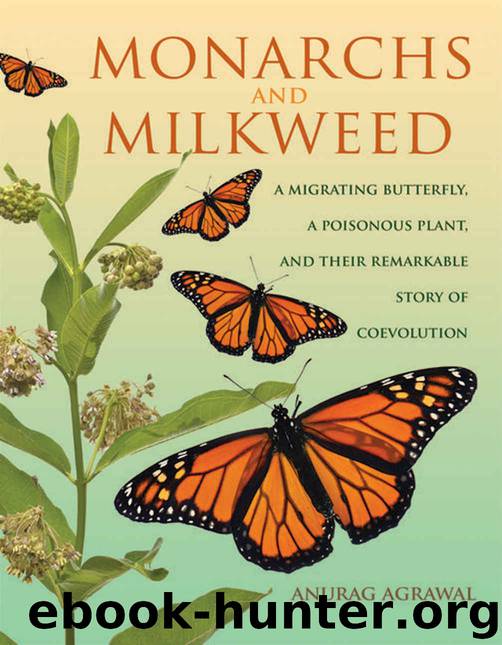Monarchs and Milkweed: A Migrating Butterfly, a Poisonous Plant, and Their Remarkable Story of Coevolution by Anurag Agrawal

Author:Anurag Agrawal [Agrawal, Anurag]
Language: eng
Format: epub
Publisher: Princeton University Press
Published: 2017-03-07T00:00:00+00:00
FIGURE 7.1. Three seed-eating milkweed insects: (a) The large and small milkweed bugs, Oncopeltus fasciatus and Lygaeus kalmii, and (b) the weevil, Rhyssomatus lineaticollis. The feeding beaks of the bugs are not visible because they are folded down along their undersides. The black coloration of Rhyssomatus is probably not aposematic, as weevils readily drop from plants, and they are very difficult to find on the ground, where they blend in with soil and tiny rocks.
For the milkweed insects, the general resource is clear, but how will we define the ways in which the resource is exploited? Like all plants, milkweed is not a single food: there are the roots, shoots, and fruits. Let’s start by dividing up the plant, top to bottom, into its main distinct parts: seeds, fruits, flowers, leaves, stem, sap, latex, and roots. The milkweed insects utilize all of these parts, although none exclusively eat the flowers or latex.
Seed Eaters
Starting at the top of the milkweed, where the seeds develop, we find three species of insect herbivores: two true bugs, the large and small milkweed bugs (Oncopeltus fasciatus and Lygaeus kalmii, respectively) both in the family Lygaei dae, and a beetle, Rhyssomatus lineaticollis, in the weevil family (Curculionidae) (fig. 7.1). These insects have a lot in common in addition to their black coloration and penchant for milkweed seeds. They have mouths at the end of “beaks” that are several millimeters long, and although they all have wings, they very rarely fly.
Adult weevils are active both in the spring and in early autumn. In the spring, however, their larvae are consumers of the stem tissue (before milkweeds have seedpods), while in the late summer their larvae are inside the pods, feasting on maturing seeds. As for the two bugs, they are indeed seed feeders, with nymphs and adults eating mature seeds when pods open. Presumably, in an evolutionary response to these feeders, milkweed seeds have triple the cardenolide concentrations of leaves. The seed-feeding guild thus has a few species that are similar, but there are important differences in when and how they attack seeds. The plant likely has specific defensive adaptations to these seed feeders that are yet to be discovered.
Suckers
Aphids are commonly (and not so affectionately) known as plant lice. They suck the sap of plants, making the plants sticky and sometimes wilty. Tiny and yet voraciously hungry and prolific, aphids are pests of farms and wildlands alike. And milkweed is home to three species: Aphis nerii, Aphis asclepiadis, and Myzocallis asclepiadis (fig. 7.2). These small suckers can be very abundant. But perhaps because they are small, and two of them are greenish, like the plants they attack, when I started working on milkweeds in the year 2000, there was not a single published study on the ecology of either Aphis asclepiadis or Myzocallis asclepiadis. Consequently, my lab group dove in and has been studying the similarities and differences among the aphid guild ever since.
When several species are in the same guild, it is thought that each species must have important distinctions that allow them all to coexist.
Download
This site does not store any files on its server. We only index and link to content provided by other sites. Please contact the content providers to delete copyright contents if any and email us, we'll remove relevant links or contents immediately.
| Cell Biology | Developmental Biology |
| Entomology | Marine Biology |
| Microbiology | Molecular Biology |
| Biostatistics |
Sapiens: A Brief History of Humankind by Yuval Noah Harari(13052)
The Tidewater Tales by John Barth(12029)
Do No Harm Stories of Life, Death and Brain Surgery by Henry Marsh(6336)
Mastermind: How to Think Like Sherlock Holmes by Maria Konnikova(6235)
The Thirst by Nesbo Jo(5785)
Why We Sleep: Unlocking the Power of Sleep and Dreams by Matthew Walker(5641)
Sapiens by Yuval Noah Harari(4537)
Life 3.0: Being Human in the Age of Artificial Intelligence by Tegmark Max(4507)
The Longevity Diet by Valter Longo(4445)
The Rules Do Not Apply by Ariel Levy(3905)
The Immortal Life of Henrietta Lacks by Rebecca Skloot(3826)
The Body: A Guide for Occupants by Bill Bryson(3800)
Why We Sleep by Matthew Walker(3771)
Animal Frequency by Melissa Alvarez(3755)
Yoga Anatomy by Kaminoff Leslie(3701)
Barron's AP Biology by Goldberg M.S. Deborah T(3631)
The Hacking of the American Mind by Robert H. Lustig(3579)
All Creatures Great and Small by James Herriot(3515)
Yoga Anatomy by Leslie Kaminoff & Amy Matthews(3395)
